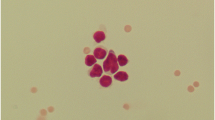Summary
The influence of artificial blood contamination on the quantitative values obtained in the routine examination of the CSF was investigated. On the basis of dilution series from CSF and blood, the correlation between the number of added erythrocytes and the results of leukocyte counts, protein, glucose and IgG estimation was studied. In addition, the influence of the time between CSF sampling and investigation on erythrocytes and leukocytes, IgG, glucose, pH value and ammonia content in CSF contaminated with blood was investigated. The following data relevant to routine examinations resulted: there are linear correlations between the number of erythrocytes artificially added to the CSF and the leukocyte count, the total protein and the IgG content, whereas glucose is unaffected by the artificial admixture of blood.
With regard to the time between sampling and investigation of the CSF, it was shown that the IgG values in blood-contaminated and blood-free CSF do not change. A correct IgG estimation is hence possible even several days after lumbar puncture. The cell count decreases exponentially with time, whereas the total protein rises with progressive cytolysis. The glucose values decrease both in native and in artificially blood-contaminated CSF, whereas the pH values rise rapidly, evidently due to release of ammonia and primary amines from the proteins and amino acids present in the CSF.
Zusammenfassung
Der Einfluß artefizieller Blutbeimengungen auf die üblichen, diagnostisch relevanten Parameter des Liquor cerebro spinalis wie Leukozytenzahl, Gesamteiweißgehalt, Immunoglobulin-G und Glukose wurden untersucht. Nativer Liquor wurde mit Blut desselben Probanden in unterschiedlichem Mischungsverhältnis versetzt. Danach wurde die Zahl der zugegebenen Erythrozyten bestimmt und zu den quantitativen Veränderungen der genannten Parameter in Beziehung gesetzt. Weiter wurde verfolgt, welchen Einfluß die Zeit zwischen Liquorentnahme und Untersuchung auf Erythrozytenzahl, Leukozytenzahl, Immunglobulin-G, Glukose, pH und Ammoniak nimmt. Es ergaben sich positive lineare Beziehungen zwischen der zugegebenen Blutmenge, gemessen an der Zahl der Erythrozyten einerseits und den Leukozyten, dem Gesamteiweiß und den Immunoglobulin-G-Gehalt, während der Glukosegehalt praktisch unverändert blieb. Zeitabhängig änderte sich der Immunglobulin-G-Gehalt nicht, so daß auch nach mehreren Tagen die quantitative Bestimmung diagnostisch bewertet werden kann. Zeitabhängig nahmen aber die Leukozytenzahlen exponentiell ab, das Gesamteiweiß nahm entsprechend exponentiell zu. Der pH-Wert stieg rasch, wahrscheinlich durch Freisetzung durch Ammoniak und Freisetzung von primären Aminen.
Similar content being viewed by others
References
Behringwerke AG Med Information und Vertrieb. Partigen Immundiffusionsplatten. D div 174: 7/73, 50
Bischoff A (1963) L'examen cytologique du liquide cephalorachidien de la methode de sedimentation et de filtration. Etude de 5000 cas. Rev neurol 108:567–575
Boehringer Mannheim GmbH (1976) Diagnostika, Testfibel Gesamteiweiß
Boehringer Mannheim GmbH (1976) Diagnostika, Testfibel Glukoquant
Colberg G (1955) Der blutige Liquor. Inauguraldissertation. Würzburg
Da Fonseca-Wollheim F (1973) Bedeutung von Wasserstoffionenkonzentration und ADP-Zusatz bei der Ammoniakbestimmung mit Glutamatdehydrogenase. Verbesserter Enzymatischer Ammoniaktest. 1. Mitteilung. Z Klin Chem klin Biochem 11:421–426
Delank HW (1972) Klinische Liquordiagnostik. Der Nervenarzt 43:2
Durfresne J-J (1973) Praktische Zytologie des Liquors. Dokumenta Geigy, Ciba Geigy AG, Basel
Gilland O (1970) Cerebrospinal fluid. Prog Neurol Psychiatry 25:214–237
Mancini GA, Carbonaro O, Hermans IF (1965) Immunochemical quantitation of antigens by single radial immunodiffusion. Immunochemistry 2:235
Merck E (1974) Klinisches Labor, Darmstadt
Olischer RM, Suchodoletz W von (1972) Zur Bewertung quantitativer Zellbefunde im bluthaltigen Liquor cerebrospinalis. Z ärztl Bldg (Jena) 213–218
Patten BM (1968) How much blood makes the cerebrospinal fluid bloody? JAMA 206:378
Sayk J (1960) Cytologie der Cerebrospinalflüssigkeit. Fischer, Jena
Schmidt RM, Seifert B (1968) Blutiger Liquor. In: Schmidt RM (ed) Der Liquor cerebrospinalis. VEB Deutscher Verlag der Wissenschaften, Berlin, pp 523–538
Vahar-Matiar H, Müller J, Lippen G (1973) Der blutige Liquor. Acta neurochirg (Vienna) 29:3–4, 229–245
Weichselbaum CTW (1946) An accurate and rapid method for the determination of proteins in small amounts of blood serum and plasma. Am J clin Pathol 16:40–49
Wüllenweber G (1924) Über die Frager der Verwendbarkeit des Liquor cerebrospinalis zu diagnostischen Zwecken bei artefizieller Blutbeimengung. Klin Wschr 3:1756–1758
Author information
Authors and Affiliations
Rights and permissions
About this article
Cite this article
Reske, A., Haferkamp, G. & Hopf, H.C. Influence of artificial blood contamination of the analysis of cerebrospinal fluid. J Neurol 226, 187–193 (1981). https://doi.org/10.1007/BF00313380
Received:
Issue Date:
DOI: https://doi.org/10.1007/BF00313380



